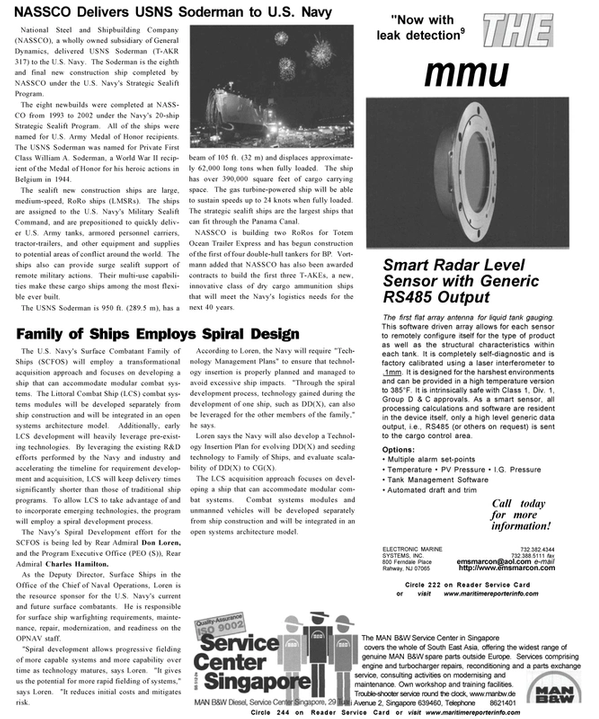
Family of Ships Employs Spiral Design
The U.S. Navy's Surface Combatant Family of Ships (SCFOS) will employ a transformational acquisition approach and focuses on developing a ship that can accommodate modular combat systems.
The Littoral Combat Ship (LCS) combat systems modules will be developed separately from ship construction and will be integrated in an open systems architecture model. Additionally, early LCS development will heavily leverage pre-existing technologies. By leveraging the existing R&D efforts performed by the Navy and industry and accelerating the timeline for requirement development and acquisition, LCS will keep delivery times significantly shorter than those of traditional ship programs. To allow LCS to take advantage of and to incorporate emerging technologies, the program will employ a spiral development process.
The Navy's Spiral Development effort for the SCFOS is being led by Rear Admiral Don Loren, and the Program Executive Office (PEO (S)), Rear Admiral Charles Hamilton.
As the Deputy Director, Surface Ships in the Office of the Chief of Naval Operations, Loren is the resource sponsor for the U.S. Navy's current and future surface combatants. He is responsible for surface ship warfighting requirements, maintenance, repair, modernization, and readiness on the OPNAV staff.
"Spiral development allows progressive fielding of more capable systems and more capability over time as technology matures, says Loren. "It gives us the potential for more rapid fielding of systems," says Loren. "It reduces initial costs and mitigates risk.
According to Loren, the Navy will require "Technology Management Plans" to ensure that technology insertion is properly planned and managed to avoid excessive ship impacts. "Through the spiral development process, technology gained during the development of one ship, such as DD(X), can also be leveraged for the other members of the family," he says.
Loren says the Navy will also develop a Technology Insertion Plan for evolving DD(X) and seeding technology to Family of Ships, and evaluate scalability of DD(X) to CG(X).
The LCS acquisition approach focuses on developing a ship that can accommodate modular combat systems. Combat systems modules and unmanned vehicles will be developed separately from ship construction and will be integrated in an open systems architecture model.
Read Family of Ships Employs Spiral Design in Pdf, Flash or Html5 edition of October 2002 Maritime Reporter
Other stories from October 2002 issue
Content
- Fincantieri Proceeds on Costa Fortuna page: 8
- The Genoa Sestri Shipyard page: 9
- RoRo Vessel Jolly Rubino Runs Aground page: 10
- Rolls Royce Engine Passes Initial Tests page: 11
- Crescent Tankships Orders Product Tankers page: 11
- The Risks of Cargo and Maritime Security page: 12
- Hydrex Broadens Its Hori^on^With Ney Bow Thruster Replacement Methods page: 18
- Keppel Performs Speedy FPSO Conversion page: 19
- ASRY Holds Another Busy Quarter page: 20
- UMC Goes Beneath The Surface page: 20
- United Defense Receives Theater Surface Award page: 20
- Where Everyone is A Celebrity page: 21
- Gladding-Hearn Delivers New Bermuda Ferry Contract page: 22
- Fresh Fuel Cell Initiatives page: 24
- Simulating Evacuation page: 26
- Houston Celebrates Rickmers Hamburg's Maiden Voyage page: 27
- Purposeful Chinese page: 27
- Izar And Rolls-Royce Plan High Speed Cargo Vessel page: 27
- The Littoral Combat Ship: Force Multiplier for the 21st Century page: 28
- NASSCO Delivers USNS Soderman to U.S. Navy page: 31
- Family of Ships Employs Spiral Design page: 31
- New Warships Will Transform U.S. Navy page: 32
- "Start Spreading the News ..." page: 33
- Retired Radm. Foley to Lead Gulfport Facility page: 34
- UFRJ Wins Student Design Competition page: 35
- KMSS Maritime Black Box: More Than Just A VDR page: 40
- Tech Helps Ignite Gas Ship Market page: 43
- How Far Has E-Procurement Come in the Maritime Community? page: 44
- Coatings Corrosion — A Natural Predator page: 46
- Haraco Services Now Part of Miihlhan Group page: 51
- New DynaMatch System Provides Versatility page: 51


